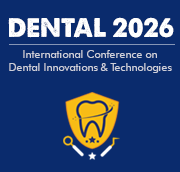TMJ and Orofacial Pain
Temporomandibular Joint (TMJ) disorders and orofacial pain are common conditions in dentistry that can cause significant discomfort for patients. The TMJ, which connects the jaw to the skull, plays a critical role in facilitating movements such as chewing, speaking, and swallowing. Any disruption in its function can result in pain, clicking sounds, or limited jaw movement. Orofacial pain extends beyond TMJ issues, affecting the mouth, jaw, and facial regions due to various conditions, including bruxism, arthritis, or nerve damage. Identifying the cause of orofacial pain is essential to determine effective treatment options, which may include physical therapy, medication, or sometimes surgical intervention. Dentists play a crucial role in diagnosing and managing these disorders, helping patients regain normal function and comfort.

David Geoffrey Gillam
Queen Mary University of London, United Kingdom
Zvi Loewy
New York Medical College, United States
Khamis A Hassan
Global Dental Research Centre, Canada
Laurindo Moacir Sassi
Erasto Gaertner Hospital Cancer Center and Mackenzie Evangelical University Hospital, Brazil
Arnaldo Castellucci
Dr. Castellucci MD, DDS, Italy
Yasser Khaled
Marquette University, United States



Title : Efficacy of a biomin F toothpaste compared to conventional toothpastes in remineralisation and dentine hypersensitivity: An overview
David Geoffrey Gillam, Queen Mary University of London, United Kingdom
Title : Importance of clinical pharmacokinetics of medications in the postoperative period of patients undergoing dental surgical procedures
Vitoldo Antonio Kozlowski Junior, Ponta Grossa State University, Brazil
Title : Dealing with peri implantitis: An insight to various treatment regimens
Preetinder Singh, Academy of Oral Surgery, United States
Title : Knowledge and attitudes of dental professionals in the evaluation of Molar Incisor Hypomineralisation (MIH): Awareness, diagnosis and treatment approaches: An overview
David Geoffrey Gillam, Queen Mary University of London, United Kingdom
Title : Single root molars prevalence and its significance in human dental evolution
Uri Zilberman, Ben-Gurion University of the Negev, Israel
Title : Enhancing root canal success strategic use of orifice opener one step synthesis gels orifice barriers
Emmanuel Samson, Consultant Total Dental Care, India